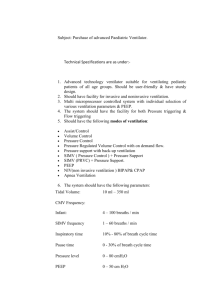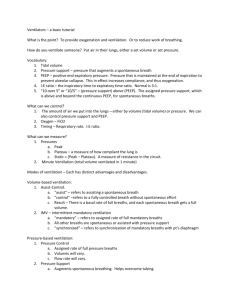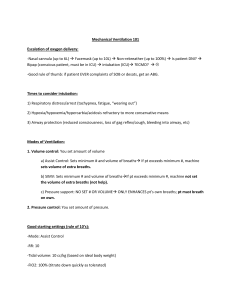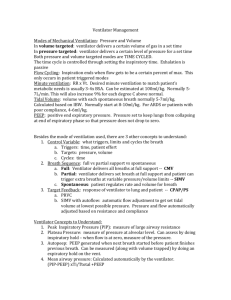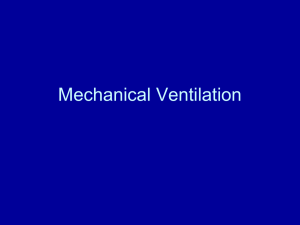Ventilator Management
advertisement
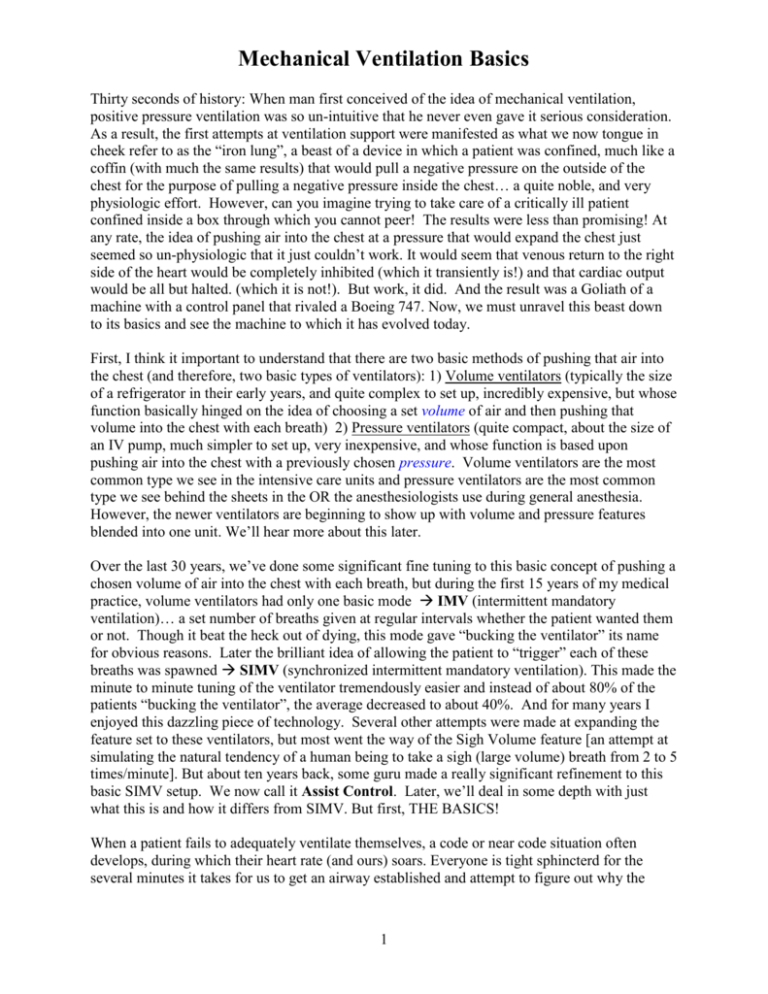
Mechanical Ventilation Basics Thirty seconds of history: When man first conceived of the idea of mechanical ventilation, positive pressure ventilation was so un-intuitive that he never even gave it serious consideration. As a result, the first attempts at ventilation support were manifested as what we now tongue in cheek refer to as the “iron lung”, a beast of a device in which a patient was confined, much like a coffin (with much the same results) that would pull a negative pressure on the outside of the chest for the purpose of pulling a negative pressure inside the chest… a quite noble, and very physiologic effort. However, can you imagine trying to take care of a critically ill patient confined inside a box through which you cannot peer! The results were less than promising! At any rate, the idea of pushing air into the chest at a pressure that would expand the chest just seemed so un-physiologic that it just couldn’t work. It would seem that venous return to the right side of the heart would be completely inhibited (which it transiently is!) and that cardiac output would be all but halted. (which it is not!). But work, it did. And the result was a Goliath of a machine with a control panel that rivaled a Boeing 747. Now, we must unravel this beast down to its basics and see the machine to which it has evolved today. First, I think it important to understand that there are two basic methods of pushing that air into the chest (and therefore, two basic types of ventilators): 1) Volume ventilators (typically the size of a refrigerator in their early years, and quite complex to set up, incredibly expensive, but whose function basically hinged on the idea of choosing a set volume of air and then pushing that volume into the chest with each breath) 2) Pressure ventilators (quite compact, about the size of an IV pump, much simpler to set up, very inexpensive, and whose function is based upon pushing air into the chest with a previously chosen pressure. Volume ventilators are the most common type we see in the intensive care units and pressure ventilators are the most common type we see behind the sheets in the OR the anesthesiologists use during general anesthesia. However, the newer ventilators are beginning to show up with volume and pressure features blended into one unit. We’ll hear more about this later. Over the last 30 years, we’ve done some significant fine tuning to this basic concept of pushing a chosen volume of air into the chest with each breath, but during the first 15 years of my medical practice, volume ventilators had only one basic mode IMV (intermittent mandatory ventilation)… a set number of breaths given at regular intervals whether the patient wanted them or not. Though it beat the heck out of dying, this mode gave “bucking the ventilator” its name for obvious reasons. Later the brilliant idea of allowing the patient to “trigger” each of these breaths was spawned SIMV (synchronized intermittent mandatory ventilation). This made the minute to minute tuning of the ventilator tremendously easier and instead of about 80% of the patients “bucking the ventilator”, the average decreased to about 40%. And for many years I enjoyed this dazzling piece of technology. Several other attempts were made at expanding the feature set to these ventilators, but most went the way of the Sigh Volume feature [an attempt at simulating the natural tendency of a human being to take a sigh (large volume) breath from 2 to 5 times/minute]. But about ten years back, some guru made a really significant refinement to this basic SIMV setup. We now call it Assist Control. Later, we’ll deal in some depth with just what this is and how it differs from SIMV. But first, THE BASICS! When a patient fails to adequately ventilate themselves, a code or near code situation often develops, during which their heart rate (and ours) soars. Everyone is tight sphincterd for the several minutes it takes for us to get an airway established and attempt to figure out why the 1 Mechanical Ventilation Basics wheel ran off the cart. It is on the heals of this terrifying event that the nurse or respiratory therapist will often turn to you with the famous question, “What vent settings do you want?” It seems that this terrifying question comes at a point when we are most stressed and least able to think straight. As a result, I have taken a very simplistic approach to teaching myself how to weather this brief storm. There are three parts to the answer to the above question: 1) THE RATE 2) THE FIO2 3) THE TIDAL VOLUME 1) RATE: This one is easy. Everyone gets a rate of 15 breaths per minute. Period. During the years of IMV, that didn’t work worth a squat. SIMV helped some, but even here more than half the patients still required some fiddling with the rate control setting during the first few hours of vent support for reasons we’ll discuss shortly. However, one of the features of Assist Control mentioned above all but solved this problem, although it has more to do with the tidal volume (more on this in a minute). With Assist Control, if you set the rate at 15 and the patient wants to breath 27 times per minute, the Assist Control mode allows them to “over breath” the ventilator’s rate setting of 15 breaths by the additional 12 breaths per minute. Herein lies the basic difference between SIMV and Assist Control. For the first 15 breaths (again, if that’s the rate you choose) both methods give the patient 15 breaths and both methods allow the patient to take the additional 12 (or however many they desire) breaths. However, it’s the difference in how Assist Control handles TIDAL VOLUME that makes it shine over SIMV. Allowing the patient to determine the rate at which they seem most comfortable bypasses the vast majority of rate related problems associated with mechanical ventilator support. 2) TIDAL VOLUME: It is here where the basic difference between SIMV and Assist Control becomes most evident. With SIMV, the patient gets 15 breaths (again if that’s what you set) at the tidal volume you set. The same is true for Assist Control. However, during the additional 12 breaths (in this example) with SIMV, the patient gets only whatever tidal volume he can muster on his own. With Assist Control, this is not the case. The patient gets the set tidal volume not only with the initial set 15 breaths, but also with the additional patient initiated 12 breaths. With this in mind, we need a simple way to select a reasonable tidal volume during the heat of the battle. For that, I use a simple 4, 5, 6 approach. In other words, 400 cc for small statured people, 500 cc for medium sized people and 600 cc for large framed people. Now if you wonder just how precise this guessing process needs to be during these initial few minutes of vent support, just bear in mind that these numbers were in the range of 500 cc, 700 cc and 900 cc for the first 15 years of my medical practice. However more recent research has concluded that the use of much smaller tidal volumes administered at somewhat higher rates reflect much better outcomes (shorter length of stay, fewer days of ventilator support required, lower morbidity/mortality, etc.). And just what do you do in this instance with the 263 pound elderly lady who, at age 18 graduated from high school weighing an envious 116 lbs? Well, she’s simply a small lady in a big package. But her lungs are the same size (if not a bit smaller) than they were when she weighed the 116 lbs. So, she gets a tidal volume of 400 cc in spite of her heavy weight. Now, I realize the literature says we should use “lean body weight”. Not a one of us, if the truth were told, ever sits down with a calculator and estimates the body weight by this method. And in fact my next assessment helps resolve this problem. Having selected a tidal volume, most residents, when asked, “What do you do next?”, respond with, “Get some ABG’s.” However, this omits a supremely important step from the initial setup process. You should walk over to the patient’s bedside, watch 2 Mechanical Ventilation Basics the patient for a moment, then take a hard look at the ventilator’s intimidating interface. On it somewhere, you will find a graphical representation of the volume of air you are pushing in (the tidal volume) and the resultant pressure that volume generates when it’s pushed in. That pressure is the key to knowing if you have guessed correctly on the tidal volume. It turns out that the pressure required to adequately ventilate the average adult (regardless of body size!!!) is in the range of 20 to 30 mmHg. Soooo, if the tidal volume you have chosen generates a pressure in this range, you have accurately guessed at the tidal volume and you don’t need a set of ABG’s to prove it. If you find the average breath-to-breath pressure to be less than 20 mmHg, you just turn up the tidal volume by 50 cc or so. Likewise, if you find the pressures to be consistently above 30 mmHg, you turn down the tidal volume by 50 cc or so. This fine-tuning of the tidal volume allows you to maximize the basic vent settings before you ever draw the first set of ABG’s. 3) FIO2: Much like the rate, I have a one size fits all approach to setting the FIO2. If in doubt, start with 100%! However, if we just stop and think for just a few seconds, we can easily break patients with respiratory failure into two broad categories… a) those with broken necks, myasthenia gravis, Guillain Barre´ Syndrome, etc. i.e. nothing wrong with their lungs; b) those with primary respiratory failure… things like acute pulmonary edema, asthma, COPD, pneumonia, near drowns, PTE, etc. For the former group, I give near room air settings, like for example, 30%. To those in the latter group, I start with high FIO2’s… like 100%. Now, it’s true that with a little experience, you can fine tune this latter 100% FIO2 approach and give some 60%, some 80% and some 100%. But it’s not at all unreasonable to just use 100% if there is any question in your mind until you get the first set of ABG’s back. Bucking the Ventilator: It has been my experience that working your way through the above basic setup will achieve adequate oxygenation in about 85% of folks with respiratory failure requiring mechanical ventilation. However, there is another 10% or so that will test your religion. These folks are the ones who, from the beginning, just keep “bucking the ventilator”. To solve this problem, we must understand what is most likely causing this phenomenon. To illustrate the problem, allow me to use an oversimplification. When you and I breathe in the course of an average day, the length of time required to take in a breath compared to the length of time it takes to blow it out is on the order of 2 to 1. In other words, it takes twice as long to take in a breath as it does to exhale it. However, for most people who require mechanical ventilation support for respiratory failure, this ratio is reversed… something on the order of 1 to 2 or 1 to 3 or somewhere in between (e.g. 1 to 2.6 or 1. 2.3). Now for the oversimplified example, let’s say it takes one second to push in the tidal volume we have set, and that it takes two seconds for the breath to passively come out. One plus two equals three. How many ventilation cycles are possible in this scenario in one minute? Well, sixty divided by three (1 second to inhale + 2 two seconds to exhale) is twenty. What if our imaginary patient is trying to breathe twenty six times per minute? Well, during those additional six breaths (26 minus 20), the last breath has not had time to get out when the ventilator tries to push in another full tidal volume! The result manifests itself in two ways. 1) The pressure generated by the partial breath that hasn’t come out yet plus the full tidal volume being pushed in pushes the pressure above the pressure alarm setting and the pressure alarm on the ventilator goes off. This alone, would not be a big deal, but this high pressure that is generated by the “stacking” of breaths triggers the person’s cough reflex and this then, causes the pressure alarm to go off a second time, and often 3 Mechanical Ventilation Basics results in repeated coughing. This breath stacking, pressure rise, coughing is what we call, “bucking the ventilator”. Now, how do we fix it? Well, from the example above, you might guess that we don’t have much control (like none) over the expiratory part of the breathing cycle. So the only variable we can alter is the length of time required to push in the chosen tidal volume. We call this the “inspiratory flow rate”. By increasing the inspiratory flow rate (pushing in the breath faster), we can effectively alter the I/E ratio toward 1 to 5 or 1 to 6 effectively allowing more ventilation cycles in the course of each minute of ventilation (e.g. if we started at 1/3.8 and we increase the inspiratory flow rate by 10%, the effect might be to move the I/E ratio to say 1 to 4.5). By moving this I/E ratio in such a fashion, we allow for more ventilaton cycles in a given minute. In practical terms, if you can keep the I/E ration in the 1/3 range in most people, this will allow for a respiratory rate up into the high 20’s/minute… plenty of rate to adequately overcome the dyspnea most patients with respiratory failure feel. PEEP: With this fine tuning of the I/E ratio noted above, we can adequately ventilate another 5 to 10% of patients requiring mechanical ventilation. That last few percent can be a real challenge (or, you might say, are by definition difficult to ventilate). So, when you have done all of the above to maximize the efficacy/efficiency of the ventilator setup, what rabbits are left in the hat if adequate oxygenation is still not achieved? Well, there is PEEP. Before you jump though, you need to understand that not only will PEEP not help everyone with respiratory failure on mechanical ventilatory support. There is a group that it will help and a group that PEEP will actually worsen. If you think a moment, you could probably guess who the folks are that PEEP will worsen. In addition to the hemodynamic effect of PEEP on right ventricular filling pressures, it also has an aerodynamic effect that is equally disastrous when used in the wrong patients. Just who might these folks be? Well, perhaps those with the primary problem of having difficulty getting their last breath out. Asthmatics and folks with other forms of COPD, like emphysema. If you apply PEEP to them, the efficacy of their mechanical ventilation will actually deteriorate! But, who will PEEP help? Those patients with “water-in-the-lung”, namely acute cardiac pulmonary edema, ARDS, near drown victims, pneumonia (a localized form of pulmonary edema), etc. Now, do we ever get patients with mixed problems… say, someone with COPD and CHF? Or COPD and pneumonia? Certainly. The problem is that using PEEP in these patients will typically help the water-in-the-lung problem (pulmonary edema/CHF/ARDS) while exacerbating their primary air trapping problem (asthma/COPD) and the net effect is that the PEEP bought you little if any extra mileage. Nevertheless watching someone die before our eyes often pushes us to desperate measures… usually with poor results. Now let’s return to the hemodynamic effect of PEEP on right ventricular filling pressures. We need to recall what the right ventricular filling pressures are… (You do remember that the left side of the heart does not pump what the right side does not send it?) Under normal circumstances the right ventricular filling pressures are pretty low… in the range of minus five to plus ten mmHg… frequently hovering around zero mmHg. PEEP is, Positive End Expiratory Pressure. The problem is that this positive pressure is not just applied at the end of the expiratory cycle as the title implies. It is applied throughout the ventilator cycle!!! That means 4 Mechanical Ventilation Basics that in order for the right side of the heart to fill with blood at its usual filling pressures, this PEEP must be overcome. At pressures approaching 10 mmHg, the PEEP frequently cannot be overcome and the result is a dramatic reduction in left heart pressures (i.e. the systolic blood pressure drops). This effect is not immediate and in fact, the way it typically happens is for you to fiddle with the vent settings for an hour or so, finally settle on a setup that achieves adequate oxygenation and off to bed you go. Just about the time your head hits the pillow, you get a call from the ICU nurse, “Doctor, Ms. Jones’ blood pressure is 60/40!” And what is your knee jerk response to a drop in blood pressure in a dog sick patient you’ve just coded and intubated? Volume. Right? Wake up. Stand beside the bed and hear my voice screaming at you! “THINK!!!!!!” Do you give more volume to a patient you just selected for PEEP because they had water-in-the-lungs? Noooooooooo!!! Vasopressors. Right? Nooooooooo!!! The left heart cannot pump what the right heart does not send it! It’s the PEEP that is the problem. So, always start low (4 to 5 mmHg) with PEEP and very cautiously increase it one or two mmHg at a time until you achieve adequate oxygenation and be ready for that phone call about the patient’s blood pressure dropping. By the time you get up in the 10 mmHg range, you are going to get the call! Now, we are down to that last few percent of survivors that in spite of all the above use of technology are still fighting the ventilator and not adequately oxygenated. This select group will require drastic measures… heavy sedation (IV Versed™ or something similar) followed by a neuromuscular blocking agent (Pavulon™, succinylcholine or something similar). From here, all the above measures are maximized. In other words, if the FIO2 is not 100%, turn it up. Set the I/E ratio optimized to allow for the highest cycling rate you can achieve. If the patient falls in the water-in-the-lung category, optimize the PEEP to the point where it induces hypotension, then back it down 2 mmHg. If these measures fail, you are ready to hang crepe with the patient’s family because the curtains are about to come down. You have done all you can do. VENTILATOR WEANING: On a lighter note, for those who survived our efforts to this point, we have much better odds of getting them through it. However, the war is not over. We have won the first volley, but many more battles are to come. Over the next day or two, our ventilation efforts are generally focused on maintaining adequate oxygenation while giving the patient time to recover from whatever caused the initial insult (MI, sepsis, PTE, pneumonia, etc.). By the morning of the third day (if not before, in problems like near drowns and drug overdoses, where the patient can often be extubated the second morning) one should begin planning for the weaning process. This is most often a mind game in which you walk in every morning, look at the patient and try to decide if this is the day. There are many traditional predictors of weaning outcome that cumulatively are used to make the decision whether the patient is ready to start the process. At this point I would refer you to UpToDate™ on the topic of Rapid Shallow Breathing Index (RSBI) and other predictors (Work of Breathing Index, Minute Ventilation, Maximum Inspiratory Pressure, Occlusion Pressures, etc). Of all these, the RSBI is probably the best. It is simple to perform and I like simple approaches to complex subjects. However I’ll have to admit I gave up using it for a yet simpler approach. In my experience the two most useful predictors are: 1) The patient’s mental status (is he awake, alert, has following eye movements, able to communicate, etc.) 2) Adequate oxygenation (In some cases of respiratory failure, we are not just fretting over the O2 level, but also may be battling hypercarbia in COPD patients. These require special measures 5 Mechanical Ventilation Basics discussed in more detail below COPD with hypoxemia and hypercarbia). The latter of these is pretty straight ahead. You just look at the ABG’s and the PO2 is either above 80 or it’s not. If it’s not, they are probably not ready for weaning. Simple enough. The assessment of the patient’s mental and general physical status is a little more involved. I think it might be helpful for you to visualize how I might go through assessing this former predictor of weaning success. On that second or third morning, as you enter the room, before you ever touch (wake) the patient, just stand there and watch them breath for a moment. If the family is present, do it anyway. Is the patient showing any evidence of struggling, any effort at breathing or triggering the ventilator. If they are, that’s a bad sign. Once you have observed them for a moment, reach over and turn the alarm on the ventilator off (If you don’t know where the vent alarm is, ask the respiratory therapist to show you so you will know the next time.) and disconnect the ventilator from the endotracheal tube. Now, just stand there and watch them breath for a couple of minutes or so. I’ve found it helpful at that moment to turn my attention to any family present and spend a few minutes talking with them, while keeping an observant eye on the patient. By the time you have observed them for a few minutes breathing on their own, off all ventilator support, and they are not taking rapid shallow breaths and don’t look distressed, you have the basic information the RSBI would tell you. From this point, one need only give weaning a shot. If, on the other hand the person is working hard to breath, breathing faster and noticeably uncomfortable, it’s probably best to rest them on Assist Control another day and try again tomorrow. It’s important here to understand that you don’t have to be successful at the weaning process a high percentage of the time. If you fail, all is not lost. You just try again the next day. What you don’t want to do is go day after day just following labs, observing, but never giving weaning a try. Most physicians are too gun shy about taking a shot at weaning early on in the course of mechanical ventilation. Try and fail, but try you do… every day! Weaning the patient with COPD with hypoxemia and hypercarbia: This represents a unique subset of folks with ventilation failure that requires special consideration. Folks with COPD are particularly difficult to wean from mechanical ventilation, but those with both COPD and chronic CO2 retention are particularly challenging. First must recognize that these patients have a very different drive to breath than other people. You and I take our next breath minute to minute controlled completely by the CO2 level in our blood. If the CO2 level rises, you breath faster. However this is not the case with a person with COPD and chronic CO2 retention. His drive to breath is hypoxemia. In other words, he must be hypoxemic in order to keep breathing! In fact, this very feature of their existence is often what lands them on mechanical ventilation support. They come to the hospital already hypercarbic and somewhat somnolent as a result, very hypoxemic (but therefore breathing) and we have the knee jerk response of placing them on 6 liters of O2. Their PO2 improves and their drive to breath goes to the Bahamas! The next step is intubation. It’s reversing this process where we really begin to stumble. If you think about it a moment and ask yourself the question, “If I had seen this person in Wal-Mart and checked a set of ABG’s, what would have been ideal for them?” Well how about a pH of 7.33 (almost compensated), PCO2 of 50 to 60 (not enough to make them somnolent), and a PO2 of 60 to 70 (low enough to leave them with a drive to breath). Why is it then, when we start the weaning process, that we want to see a PO2 of 100, PCO2 of 35 and a pH of 7.40? It makes no sense. Our goal during the weaning process should be, at best, their baseline (not normal) ABG’s. The O2 SAT’s should be about 88 to 90%, not 95%. By learning to accept these very abnormal values in this subset of patients with COPD and CO2 retention, we can enjoy much greater 6 Mechanical Ventilation Basics success in the weaning process. They are still difficult to wean, but with realistic expectations, the process goes much smoother. Weaning the average patient: The first step at weaning is to begin a stepwise reduction in the FIO2 support from 100% down toward 40%, generally in increments of 10 to 20%. In the most critically ill patients, this may take two or three days. In most it can be accomplished in a day or so. Once the FIO2 is in the 40 to 50% range, the next major step can be attempted. Having assessed your “predictors of weaning success” discussed above and make the conscious decision to take a shot at weaning, what is your next step? It is simply to change from Assist Control to SIMV. In doing so, you have effectively reduced the patient’s ventilation support by the difference in their own tidal volume in all those breaths they were taken above the set rate (in this case, 15). So, if the person was breathing 24 times/min, on Assist Control, they were getting the full (say, for example, 500 cc) set tidal volume for all 24 breaths. On SIMV, they will be getting only what they can muster (say, for example, 380 cc) for those additional 9 breaths (24 15 = 9) and the set 500 cc for the other 15 breaths. So, you see that just changing from Assist Control to SIMV reduces ventilation support in most patients. Now you have your patient on SIMV with a set rate of 15 and breathing something more than that, say 24 times/min. The next step is to begin reducing the SIMV rate. Based upon how sick the patient has been, how alert they are, how good their ABG’s look, you decrease the rate by about 3 breaths per minute for the first step (to 12/min). Let an hour or two pass, check O2 SAT’s and if adequate, go down another 2 breaths per minute to 10 per minute. Wait another hour or two and repeat the process, reducing the rate to 8 per minute. This is repeated in similar fashion down to about 4 to 6 breaths per minute and once at this level, if all has gone well, change the ventilation support to “Flow By”. At this setting, the patient is getting the set FIO2 (now down to the 40 to 50% range), but the rate and tidal volume of each breath are completely determined by the patient. If O2 SAT’s remain adequate (Most would check ABG’s after a couple of hours or so on flow by to assess not just the PO2, but the pH and PCO2 as well.), extubation can be executed. You may have noticed that to this point, I have not mentioned Pressure Support. It’s because I seldom use it. However, it can be a very useful and alternative type of ventilation support to achieve successful weaning from ventilation support. The method is very similar to weaning from SIMV rate support. As noted above, once the FIO2 has been weaned down to the 40 to 50% range, once can simply turn the SIMV off (to Flow By) and turn pressure support on to a level that will give the patient approximately the same amount of ventilation support that SIMV would have given at about 12 breaths per minute. That number turns out to be about 12 to 15 mmHg of pressure support. Remember in thinking about this how much pressure support would be equivalent to full Assist Control setting 25 mmHg of pressure support. So, changing from Assist Control in a patient breathing 24 times per minute to pressure support at 15 mmHg would be the equivalent of changing from Assist Control to SIMV at 15 breaths per minute. From that point, you could probably guess how to use pressure support to wean down to flow by. After an hour or two on pressure support at 15 mmHg, just turn the pressure support down to 12. Wait an hour or two, and if O2 SAT’s are OK, turn it down to 12 per minute. Then 10 per minute, then 8 per minute, and so forth down to flow by with no pressure support. I think most pulmonologists would part with me at this point. Most would say that the resistance in the tubing (being smaller in diameter than the upper airway) would require about 5 mmHg of pressure support to overcome. And to this statement, I would agree. Still I don’t use pressure support. It has been my experience that if the patient cannot handle 5 mmHg of pressure support caused by the line resistance, he is not 7 Mechanical Ventilation Basics ready to be extubated. The rare exception might be a patient with COPD and chronic CO2 retention who lives with crossed or near crossed gasses, an occasional patient with severe pulmonary fibrosis or some other lung disease where their basic metabolic state is so close to death that they just have no margin for error. In this select few, using a few mmHg of pressure support to get them through that couple of hours on flow by might be warranted. Most, however, will do just fine with no pressure support. If they struggle without it, you may well find yourself in a few hours back intubating them again… not a pleasant experience in any case. Many pulmonologists utilize pressure support simultaneously with SIMV in the process of weaning from ventilation support. To me, it makes no sense to mix the two in most cases. However, in managing patients in concert with several pulmonologists now for many years, I know there are a host of individualized methods of achieving good results with all the above discussed methods of ventilation management that are quite different from my own approach. And that is quite OK. There is a pretty wide range of variance between individual pulmonologists as well. My method is just that… one method that works, and works quite well. With experience, you will undoubtedly develop your own approach with which you become successful. A. Robert Sheppard, M.D. Associate Professor of Medicine Director, Hospitalist Services College of Community Health Sciences University of Alabama School of Medicine 8
